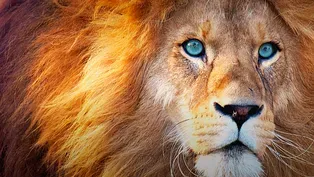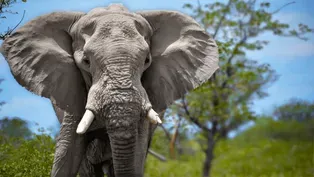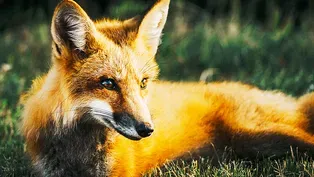
Dolphins Can Use Technology!?
Episode 8 | 7m 20sVideo has Audio Description, Closed Captions
We learn about the tremendous brainpower dolphins really have!
We all know they can jump through hoops, but just how much brainpower do dolphins have? Surely they can’t use a giant underwater touchscreen… can they? (they can!) This week Natalia called Dr. Diana Riess a dolphin intelligence expert from Hunter College and Ph.D student Diana Rocha of the World Cetacean Alliance and Dolphin Encountours to learn more about these precocious porpoises.
See all videos with Audio DescriptionADProblems with Closed Captions? Closed Captioning Feedback
Problems with Closed Captions? Closed Captioning Feedback

Dolphins Can Use Technology!?
Episode 8 | 7m 20sVideo has Audio Description, Closed Captions
We all know they can jump through hoops, but just how much brainpower do dolphins have? Surely they can’t use a giant underwater touchscreen… can they? (they can!) This week Natalia called Dr. Diana Riess a dolphin intelligence expert from Hunter College and Ph.D student Diana Rocha of the World Cetacean Alliance and Dolphin Encountours to learn more about these precocious porpoises.
See all videos with Audio DescriptionADProblems with Closed Captions? Closed Captioning Feedback
How to Watch Animal IQ
Animal IQ is available to stream on pbs.org and the free PBS App, available on iPhone, Apple TV, Android TV, Android smartphones, Amazon Fire TV, Amazon Fire Tablet, Roku, Samsung Smart TV, and Vizio.
Providing Support for PBS.org
Learn Moreabout PBS online sponsorshipMore from This Collection
There Are No Actual ‘Lion Kings’
Video has Audio Description, Closed Captions
Sorry to ruin your childhood, but a "lion king" doesn't exist. But, here is what does! (8m 22s)
Otters: Cute, Playful, Geniuses?
Video has Audio Description, Closed Captions
Otters are some of the most beloved creatures in the water but are they geniuses too? (9m 42s)
Video has Audio Description, Closed Captions
Find out the amazing things we can learn about Rats! (7m 43s)
Elephants: Do Giant Brains Mean More Smarts?
Video has Audio Description, Closed Captions
Let's explore, outside of memory, how intelligent elephants are. (11m 38s)
Baby Penguins Can Navigate Better than You
Video has Audio Description, Closed Captions
Penguins are fascinating creatures, not just because of their physical characteristics. (8m 27s)
Foxes: Dog Hardware, Cat Software
Video has Audio Description, Closed Captions
What can we learn about animal intelligence from domesticated foxes? (8m 55s)
How Intelligent are Dogs, Really?
Video has Audio Description, Closed Captions
Did we domesticate the brains out of our favorite companions? (9m 17s)
Providing Support for PBS.org
Learn Moreabout PBS online sponsorshipHey, Trace.
How are you?
Hey, what's up?
(speaker) Do you remember the last time you were at a bar or a cocktail party?
(Trace) Oh, gosh, it's been a year.
Thanks, pandemic.
Do you remember how loud it could get?
And then imagine trying to find your friend in a crowded bar.
They're all the way across the room.
Could you find them just by their voice?
I don't think I could, but I've heard of this and I know where you're going.
It's the cocktail party effect, right?
[chuckles] Exactly.
Yeah, penguins use their tiny ears and their wonderful little brains to filter the exact call of their mate or their chick from thousands or tens of thousands of other individuals.
And they do this, of course, while wearing tuxedos, Natalia.
(Natalia) Yep, all dressed up, but nowhere to go to show off their amazing intellect.
Welcome to Animal IQ, everyone.
In each episode of this show, we pick an animal and then we measure their intelligence in our intelligence rubric.
And this week, we've got penguins.
(speaker) Yep, and our rubric has five domains.
Each domain can be affected by genetics, evolution, and the environment.
And although comparing intelligence among animals can be tricky, the rubric gives us kind of an idea of where an animal might fall according to science.
We first like to mention the encephalization quotient for each of our animals.
EQ is a general indicator of intelligence, like BMI for brains.
It means the brain-to-body-mass ratio.
And in this case, penguins average about 0.9.
For comparison, humans range from 7.5 to 7.8.
But remember, raw size does not determine intelligence.
Penguins have extremely accurate senses of direction, and that means they will do ridiculously well on our ecological measures.
We should definitely max them out on both social and ecological domains.
They are master navigators with a remarkable memory.
So they live in these massive colonies, and king penguin chicks have to navigate their way through these masses, back home to their parents.
And they don't even build nests, it's just an area that they're navigating back to.
(Trace) I think even humans would find that pretty challenging, and penguin babies, they do this all the time.
The chicks can be displaced by predators or weather.
They can literally be blown away and they have to find their way back to their exact creche.
(Natalia) Exactly, and the colony's shifting and moving around.
That's thousands of bird shifting around that these chicks have to navigate their way home through.
That's wild.
I just picture, like, an outdoor festival or concert.
You go to get food and then you have to find your way back to your blanket while holding it, and you don't even know where to go.
And penguin chicks do this all the time.
And they use smells and visual cues, like lakes and hills, and information literally carried to them on the wind to find their way back.
I'm an adult, and I couldn't even do this, but 10-month-old king penguin chicks are able to find their way to one square meter of space from half a kilometer away.
(Trace) Where are the parents?
I'm glad you're wondering.
They're taking turns working with other penguins, cooperatively hunting and gathering fish, to feed their chicks.
African Penguins actually hunt collectively in groups.
They gather food three times more efficiently than species that hunt solo.
They have to use rapid information processing to do this-- they have to predict where the fish are gonna go, they have to see the other penguins in this three-dimensional space while swimming.
They can catch so many fish.
And so, to learn more about how penguins see the world, I called an expert, Livio Favaro.
What I can tell you for the African penguin is that they live in huge colony of hundred or thousand of individuals.
Basically during the foraging trips, when it's--when it's breeding season, small patches, small group of penguins of, let's say 10, 12, 20 penguins, they leave the colony all together and they go at sea for foraging.
They use contact calls when they float on the sea surface to keep in touch to each other and they have complex hunting strategies when they dive.
There is some kind of social collective behavior in-in-in terms of foraging.
We have evidence that they bas-- basically they react more to the incongruent calls, which means basically they are more surprised to hear a call of an individual, and this means that they probably combine to build the mental representation of the call specific.
Not only acoustic cues but, as we do, also visual cues, and who knows, probably also olfactory cues, which is some cognitive abilities that tell us that probably they have more complex cognitive skills than previously thought.
So we get it, penguins.
Amazing at social interaction, amazing mappers, but there's other cool things that they do, right?
Yeah, the little blue penguin will even eavesdrop on fights.
So, to gauge power dynamics in their colony and figure out who's winning in a fight, they'll eavesdrop, and eavesdropping males are less likely to challenge winner of these fights.
(Trace) That is definitely points for our eco measure.
I remember this study, it's incredible.
Researchers actually played calls from a winner and loser of, like, a penguin fight and used a fake egg with an infrared sensor in it to scan the penguin's heartbeats.
So, when they would play the calls of the big, tough winning penguin, the other male hearts skyrocketed.
'Cause they didn't want to mess with that one.
Honestly though, I think we can all relate to this.
We've all been in this kind of situation.
I mean, before we were stuck at home all the time.
As long as we're talking about social domain scores, did you know the penguins can also follow the gaze of other penguins?
So, if the penguin is checking something out, the other penguins will try to see what it's looking at.
Researchers use laser pointers to get the attention of one penguin, and then the other penguins would follow their gaze to try and check out what they're looking at.
[laughs] It's like a penguin version of standing on a street corner doing this.
[giggles] Exactly.
So that's a great bump in awareness, as they can tell individuals apart.
But we don't know if they're aware that they are individuals themselves, say, when they look in a mirror.
It's a test that hasn't been done yet, at least not that we could find.
Okay, so let's look at our rubric and see how they score.
They score really high in the social category.
They make sounds for specific things, like advertising when they win a fight; they eavesdrop on each other, they can recognize each other's voices.
And they also score highly in the ecological domain.
They have these excellent mapping skills and are able to find their way back to their nest through the masses.
(Trace) Penguins.
Wow.
All of that, plus their ability to coordinate and hunt even when they're underwater, to eavesdrop on each other to pick up on that local colony drama, which is so human-like.
And of course, they're always dressed to impress, right?
Natalia, with that in mind, I'd love to get your opinion on the penguin X-factor.
I'd say we place them fairly high.
I'm really impressed with them so far, and there's still a lot of research to be done.
And honestly, I'm directionally challenged.
So their navigational skills, I just am in awe of.
Oh, man, wow, first bird on Animal IQ, and we knocked it out of the glacier park.
What animals should we look into next?
So far, we've done birds, human-friendly mammals.
What do you think?
What's your favorite animal?
Penguins are pretty high up on my list, but not my favorite.
Thanks for watching Animal IQ.
We'll see you next time.
[light music playing] Accessibility provided by the U.S. Department of Education.



















